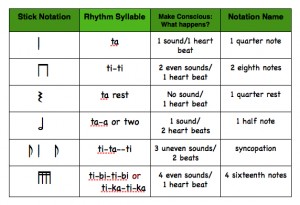Kodály Rhythm: An Introduction
This is a guest post by Yoon Soo Lim, a music teacher and department chair at an independent music school in Pennsylvania. Yoon holds undergrad and grad degrees in piano performance. When she discovered her love for teaching, Yoon pursued Kodály certification. She teaches guitar and general music classes, advises a guitar club, and conducts two choirs. Check out her blog, Sing Imagination, and follow her on twitter.
There are many ways to help young musicians establish a good sense of rhythm. The following post is based on the Kodály method that presents a rhythmic study in easy, fun, and sequential steps.

What happened to the note heads?
Before you got to “read” this simple two-bar example, you might have noticed missing note heads. The Kodály method utilizes stick notation (stems without note heads) to easily get students’ focus on the rhythm. It is also easier for students to write fast and accurately. This is a very useful tool for rhythmic dictation.
In traditional music reading, one could read, “quarter note, two eighth notes, two eighth notes, quarter note” etc. Or one could simply tap out the rhythm. In a Kodály music class, traditional note value names are given syllable names. These rhythmic syllables represent the number of sounds that occur over one beat. For instance, a quarter note, is called a “ta”, one sound that occurs over one beat. The symbol is |. Here is a chart of basic rhythms:
Try writing out example 1 or your own rhythmic patterns on a piece of paper to get yourself used to the notation. You will find how easy it is to write and organize.
How to introduce Kodály rhythm to students: Preparation, Presentation, & Practice
All of the rhythms in a Kodály music class get introduced through songs that contain the same rhythmic patterns. Songs are learned first, usually taught by rote from the teacher. Students sing the song, play games and engage in activities that are related to the song. Then the melodic rhythmic concepts are presented and practiced.
After you have your student hear the new piece, allow time for him/her to read and think the rhythm (inner-hearing). You can do this by having the student read the piece silently. Silent reading is prepared by teacher’s “guided steady count-aloud” for the piece. For instance, in a 4/4 piece, teacher will prep count in a slow steady tempo of a four-beat, “1, 2, and here you go”; student will begin reading silently on the down beat.
This guided steady beat can be shown by the teacher while the student is reading silently. When guiding, teacher can point to each beat while the student reads silently. The second time, the teacher can “prep count” again and have the student read aloud with rhythmic syllables. As the student builds confidence and is able to read accurately, you can increase the tempo or play extra challenge games.
One of the fun memory games my students enjoy is “Turn it Over”. For this game, you will need 4-8 rhythmic cards containing patterns your student is or will be working on. Here are 4 cards for beginners:
You can arrange the cards in this order on a music stand. In a steady tempo, the student reads the 16-beat pattern. After a solid read, ask the student, “Which one do you want to turn over?”. The student will choose a card to turn over. In the case above, almost always, student choose the first card. The next time the student “reads” the 16-beat pattern, the student is expected to remember the card he or she turns over. One by one, the cards will be turned over while the student memorizes the 16-beat pattern. Remember to give some time for your student to learn a card before turning over the next card. The repetitive nature of this game helps students retain rhythms well and accurately. And it’s a fun challenge!
All of these basic notation introduced in this post usually get covered in Kodály music classes in Kindergarten – 3rd grades. If you are a private instrumental teacher teaching young students or older beginner students, I suggest that you start your students with these syllables from the beginning of their lessons with you and build your rhythmic vocabulary with them. You can determine when to switch over to the traditional notation names (or use interchangeably) as you assess each student’s understanding and growth.


Meredith
Another great method similar to Kodály is the Takadimi method. Instead of teaching different syllables for each note value it teaches the division of the beat. For instance a quarter note would be read as ta but two eighth notes would be read as ta-di. What would be read as ti ta ti in Kodály would be read as ta di_ di in this system showing that the second and third notes come on the off-beat. It’s worth looking into it if you never have before.
My Guest Post at The Classical Guitar Blog | Sing Imagination
[…] Read Kodály Rhythm: An Introduction here. […]
Zach Eapen
This is an entirely new thing for me. Great info. Truly a revolutionary form to denote the rhythm patterns. Thanks for the information. As someone has commented Thakadhimi method is also a good system, which is an Indian method of denoting rhythms, and they use a percussion instrument called ‘Tabla’ for that.
Wayne
This looks very similar to Konokol. John McGlaughlin has produced an outstanding DVD on the subject. I forget the name of the Indian gentleman who appears on the DVD but it is worth seeing him recite the rythm patterns just for the entertainment value.